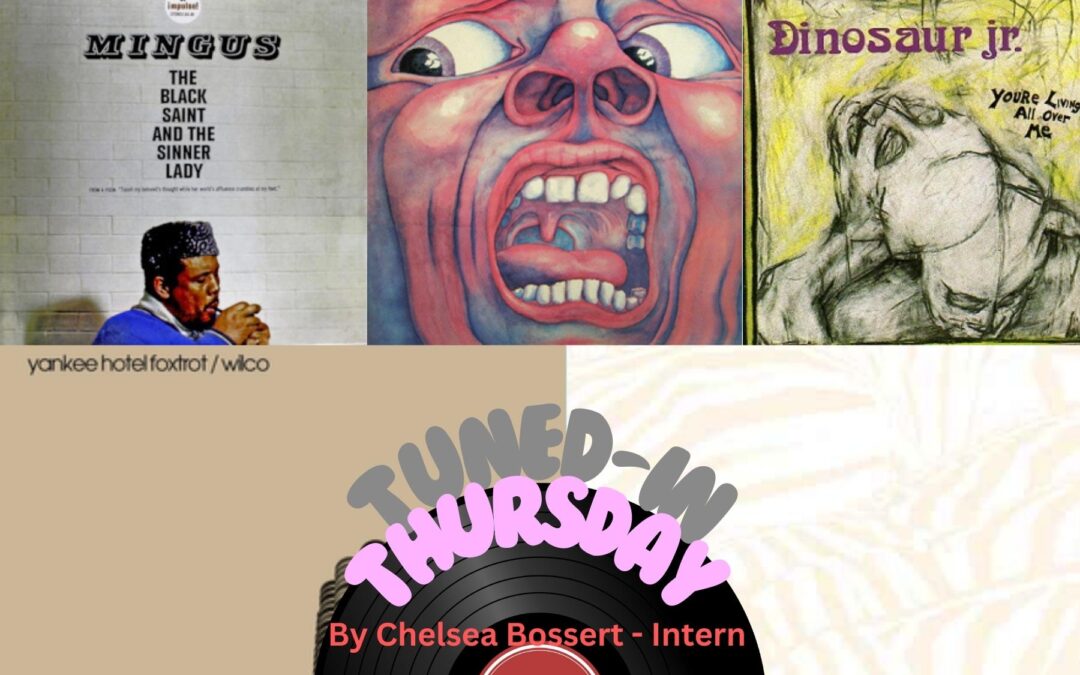Throughout my entire adult life, my music taste has been kind of all over the place. Starting off with hard rock, then transitioning to alternative hip-hop, then going full indie – one thing has been clear: I like what I like. When people try to rank their favorite albums of all time, sometimes they skip over recent releases (within the last 25 years.) For me, popular albums from the last fifty years have been taken into consideration when talking about my favorite albums of all time.
Album lists also have to be comprehensive by genre. When creating a top five or top ten of all time you cannot just have a bunch of jazz, or just hip-hop, or just rock albums. It has to have diversity. Which is why for me, my top five albums of all time include two rock albums, two indie albums and a jazz record.
Here they are:
#5 – “In The Court of the Crimson King” by King Crimson (1969)
King Crimson’s 1969 debut record, “In The Court of the Crimson King,” combines both jazz and progressive rock into a record that is more fun to be talked about than to be listened to in a certain way. Bombastic and epic instrumentation and vocals that are befitting to a medieval style rock band bathe the tracks in a sort of elegance. It seems to me that King Crimson opted to go for more of a stylistic record than one of substance. This is apparent by how bonkers some of the lyrics are on tracks like “21st Century Schizoid Man” and the closing title track. Nevertheless, King Crimson’s legacy and infamy comes with this being one of the greatest concept records and one of my favorites of all time.
#4 – “Yankee Hotel Foxtrot” by Wilco (2002)
Combining the aesthetics of early-2000s “indie sleaze” and the sonics of late-90s alt-country, Wilco’s “Yankee Hotel Foxtrot” is a treat for fans of both, and even for fans of neither. Vocalist Jeff Tweedy’s musings over twangy yet driving guitar and drum instrumentation gives off a vibe of someone who’s seen it all, but still hungry for more. The fact that Wilco can put together catchy, relatable and powerful tracks will still maintaining their accessibility and fun is truly staggering. “Kamera,” War on War,” and “Jesus, etc.” is a part of a great track-run that just keeps on giving the further you go into the album.
#3 – “You’re Living All Over Me” by Dinosaur Jr. (1987)
Commonly thought of as a “proto-grunge” album, Dinosaur Jr.’s (or Dinosaur’s if you’ve been following the band for long enough,) 1987 record, “You’re Living All Over Me” is a pre-grunge noise rock masterclass in both songwriting and atmosphere. Much like some other albums on this list, “You’re Living All Over Me” serves as a lens into what circumstances led to the overhaul of rock music in the 1990s. The reason why tracks like “Little Fury Things,” “Cracked,” “Sludgefeast” and “Tarpit” resonate with me so much is that there are not merely progenitors to bands like Nirvana, but they excel in their respective lanes as textured music pieces.
#2 – “Teen Dream” by Beach House (2010)
Revivalism can be tricky – especially if you are a band who likes to not stray far from your roots and influences. When I first got into Beach House, I laid back with a cautious optimism and was pleasantly surprised by how light and accessible most of the albums were (aside from a few excpetions.) Tracks like “10 Mile Stereo,” “Norway” and the infamous and endlessly catchy “Silver Soul” paint a beautiful landscape of awe, wonder and beauty in a genre that absolutely overstayed its welcome in the mid-2000s. However, with Beach House’s 2010 magnum opus, Teen Dream, dream pop rose from the ashes and brought a new sense of adventure to a genre that looked like it was on its way out.
#1 – “The Black Saint and the Sinner Lady” by Charles Mingus (1963)
Music, most often, is inherently tied to ones’ own emotions. This is because we make these emotional connections with music through when and where we first listened to certain songs/records/albums. We can also sense the emotional subtext the music is trying to convey to us through its musicality. “The Black Saint” is no different. Arguably Mingus’s best and most well-known work, this is my favorite jazz record and my favorite album of all time. The way Mingus mixes ballet, flamenco, third stream jazz and experimental big-band is impressive to say the least. Sprawled over four tracks and forty minutes, Mingus frames the musical progression through the progression of a ballet, such as “Black Swan.” There are no vocals on the record, however, you can feel the pulling and pushing of the narrative through sax, horns and other instruments at different points on the album. Every time I listen to the start of this record on a whim, I have to go all the way through – it’s that good. Overall, Mingus’s masterpiece impresses not only jazz enthusiasts, but jazz-listening amateurs like myself.

